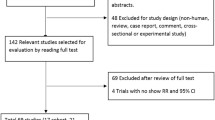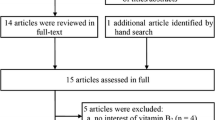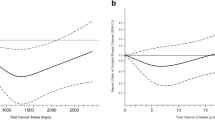Abstract
No studies of dietary vitamin D intake and vitamin D receptor (VDR) have been conducted comparing breast risk among Hispanic women and non-Hispanic white (NHW) women. We investigated the association between vitamin D intake and breast cancer in a population-based case–control study of 1,527 NHW and 791 Hispanic breast cancer cases diagnosed in 1999–2004 in Arizona, New Mexico, Utah, and Colorado, and 1,599 NHW and 922 Hispanic age-matched controls. Vitamin D intake was assessed using food frequency questionnaires, and associations with breast cancer were adjusted for age, ethnicity, state, education, body mass index, smoking, age at menarche, age at first birth, parity, hormone exposure, height, and physical activity using logistic regression. BsmI, Poly A and FokI vitamin D receptor (VDR) genotypes were also measured. Dietary vitamin D intake was positively associated with breast cancer (highest vs. lowest quartile (Q 4 vs. Q 1): odds ratio (OR) = 1.35, 95% confidence interval (CI) = 1.15–1.60; P trend = 0.003), whereas vitamin D supplement use was inversely associated with breast cancer (10+ μg/day vs. none: OR = 0.79, 95% CI = 0.65–0.96, P trend = 0.01). Similar patterns in risk were observed by ethnicity and menopausal status. Positive associations with dietary vitamin D intake and inverse associations with supplement use were observed for ER+/PR+ and ER−/PR− breast cancers, but not for ER+/PR− disease. BsmI genotype significantly modified the association between dietary vitamin D and breast cancer overall. Future research is needed to better understand potential differences in breast cancer risk by vitamin D source and hormone receptor status.
Similar content being viewed by others
References
Abbas S, Linseisen J, Slanger T, Kropp S, Mutschelknauss EJ, Flesch-Janys D, Chang-Claude J (2008) Serum 25-hydroxyvitamin D and risk of post-menopausal breast cancer—results of a large case–control study. Carcinogenesis 29:93–99
Bertone-Johnson ER, Chen WY, Holick MF, Hollis BW, Colditz GA, Willett WC, Hankinson SE (2005) Plasma 25-hydroxyvitamin D and 1,25-dihydroxyvitamin D and risk of breast cancer. Cancer Epidemiol Biomarkers Prev 14:1991–1997
Crew KD, Gammon MD, Steck SE, Hershman DL, Cremers S, Dworakowski E, Shane E, Terry MB, Desai M, Teitelbaum SL, Neugut AI, Santella RM (2009) Association between plasma 25-hydroxyvitamin D and breast cancer risk. Cancer Prev Res (Phila Pa) 2:598–604
Janowsky EC, Lester GE, Weinberg CR, Millikan RC, Schildkraut JM, Garrett PA, Hulka BS (1999) Association between low levels of 1,25-dihydroxyvitamin D and breast cancer risk. Public Health Nutr 2:283–291
Lowe LC, Guy M, Mansi JL, Peckitt C, Bliss J, Wilson RG, Colston KW (2005) Plasma 25-hydroxy vitamin D concentrations, vitamin D receptor genotype and breast cancer risk in a UK Caucasian population. Eur J Cancer 41:1164–1169
Frazier AL, Ryan CT, Rockett H, Willett WC, Colditz GA (2003) Adolescent diet and risk of breast cancer. Breast Cancer Res 5:R59–R64
Frazier AL, Li L, Cho E, Willett WC, Colditz GA (2004) Adolescent diet and risk of breast cancer. Cancer Causes Control 15:73–82
John EM, Schwartz GG, Dreon DM, Koo J (1999) Vitamin D and breast cancer risk: the NHANES I epidemiologic follow-up study, 1971–1975 to 1992. National Health and Nutrition Examination Survey. Cancer Epidemiol Biomarkers Prev 8:399–406
Levi F, Pasche C, Lucchini F, La VC (2001) Dietary intake of selected micronutrients and breast-cancer risk. Int J Cancer 91:260–263
Lin J, Manson JE, Lee IM, Cook NR, Buring JE, Zhang SM (2007) Intakes of calcium and vitamin D and breast cancer risk in women. Arch Intern Med 167:1050–1059
McCullough ML, Rodriguez C, Diver WR, Feigelson HS, Stevens VL, Thun MJ, Calle EE (2005) Dairy, calcium, and vitamin D intake and postmenopausal breast cancer risk in the Cancer Prevention Study II Nutrition Cohort. Cancer Epidemiol Biomarkers Prev 14:2898–2904
Robien K, Cutler GJ, Lazovich D (2007) Vitamin D intake and breast cancer risk in postmenopausal women: the Iowa Women’s Health Study. Cancer Causes Control 18:775–782
Shin MH, Holmes MD, Hankinson SE, Wu K, Colditz GA, Willett WC (2002) Intake of dairy products, calcium, and vitamin D and risk of breast cancer. J Natl Cancer Inst 94:1301–1311
Murtaugh MA, Sweeney C, Giuliano AR, Herrick JS, Hines L, Byers T, Baumgartner KB, Slattery ML (2008) Diet patterns and breast cancer risk in Hispanic and non-Hispanic white women: the Four-Corners Breast Cancer Study. Am J Clin Nutr 87:978–984
Armas LA, Dowell S, Akhter M, Duthuluru S, Huerter C, Hollis BW, Lund R, Heaney RP (2007) Ultraviolet-B radiation increases serum 25-hydroxyvitamin D levels: the effect of UVB dose and skin color. J Am Acad Dermatol 57:588–593
Clemens TL, Adams JS, Henderson SL, Holick MF (1982) Increased skin pigment reduces the capacity of skin to synthesise vitamin D3. Lancet 1:74–76
Slattery ML, Sweeney C, Edwards S, Herrick J, Baumgartner K, Wolff R, Murtaugh M, Baumgartner R, Giuliano A, Byers T (2006) Body size, weight change, fat distribution and breast cancer risk in Hispanic and non-Hispanic white women. Breast Cancer Res Treat 102(1):85–101
Slattery ML, Sweeney C, Wolff R, Herrick J, Baumgartner K, Giuliano A, Byers T (2006) Genetic variation in IGF1, IGFBP3, IRS1, IRS2 and risk of breast cancer in women living in Southwestern United States. Breast Cancer Res Treat 104(2):197–209
Sweeney C, Edwards SL, Baumgartner KB, Herrick JS, Palmer LE, Murtaugh MA, Stroup A, Slattery ML (2007) Recruiting Hispanic women for a population-based study: validity of surname search and characteristics of nonparticipants. Am J Epidemiol 166:1210–1219
Liu K, Slattery M, Jacobs D Jr, Cutter G, McDonald A, Van HL, Hilner JE, Caan B, Bragg C, Dyer A (1994) A study of the reliability and comparative validity of the cardia dietary history. Ethn Dis 4:15–27
Slattery ML, Caan BJ, Duncan D, Berry TD, Coates A, Kerber R (1994) A computerized diet history questionnaire for epidemiologic studies. J Am Diet Assoc 94:761–766
Harris SS, Eccleshall TR, Gross C, wson-Hughes B, Feldman D (1997) The vitamin D receptor start codon polymorphism (FokI) and bone mineral density in premenopausal American black and white women. J Bone Miner Res 12:1043–1048
McClure L, Eccleshall TR, Gross C, Villa ML, Lin N, Ramaswamy V, Kohlmeier L, Kelsey JL, Marcus R, Feldman D (1997) Vitamin D receptor polymorphisms, bone mineral density, and bone metabolism in postmenopausal Mexican-American women. J Bone Miner Res 12:234–240
Slatter ML, Yakumo K, Hoffman M, Neuhausen S (2001) Variants of the VDR gene and risk of colon cancer (United States). Cancer Causes Control 12:359–364
Knight JA, Lesosky M, Barnett H, Raboud JM, Vieth R (2007) Vitamin D and reduced risk of breast cancer: a population-based case-control study. Cancer Epidemiol Biomarkers Prev 16:422–429
Rossi M, McLaughlin JK, Lagiou P, Bosetti C, Talamini R, Lipworth L, Giacosa A, Montella M, Franceschi S, Negri E, La VC (2009) Vitamin D intake and breast cancer risk: a case–control study in Italy. Ann Oncol 20:374–378
Anderson LN, Cotterchio M, Vieth R, Knight JA (2010) Vitamin D and calcium intakes and breast cancer risk in pre- and postmenopausal women. Am J Clin Nutr 91:1699–1707
Goodwin PJ, Ennis M, Pritchard KI, Koo J, Hood N (2009) Prognostic effects of 25-hydroxyvitamin D levels in early breast cancer. J Clin Oncol 27:3757–3763
Colston KW (2008) Vitamin D and breast cancer risk. Best Pract Res Clin Endocrinol Metab 22:587–599
Bogh MK, Schmedes AV, Philipsen PA, Thieden E, Wulf HC (2010) Vitamin D production after UVB exposure depends on baseline vitamin D and total cholesterol but not on skin pigmentation. J Invest Dermatol 130:546–553
Brazerol WF, McPhee AJ, Mimouni F, Specker BL, Tsang RC (1988) Serial ultraviolet B exposure and serum 25 hydroxyvitamin D response in young adult American blacks and whites: no racial differences. J Am Coll Nutr 7:111–118
Blackmore KM, Lesosky M, Barnett H, Raboud JM, Vieth R, Knight JA (2008) Vitamin D from dietary intake and sunlight exposure and the risk of hormone-receptor-defined breast cancer. Am J Epidemiol 168:915–924
Lee HJ, Paul S, Atalla N, Thomas PE, Lin X, Yang I, Buckley B, Lu G, Zheng X, Lou YR, Conney AH, Maehr H, Adorini L, Uskokovic M, Suh N (2008) Gemini vitamin D analogues inhibit estrogen receptor-positive and estrogen receptor-negative mammary tumorigenesis without hypercalcemic toxicity. Cancer Prev Res (Phila Pa) 1:476–484
Bretherton-Watt D, Given-Wilson R, Mansi JL, Thomas V, Carter N, Colston KW (2001) Vitamin D receptor gene polymorphisms are associated with breast cancer risk in a UK Caucasian population. Br J Cancer 85:171–175
Raimondi S, Johansson H, Maisonneuve P, Gandini S (2009) Review and meta-analysis on vitamin D receptor polymorphisms and cancer risk. Carcinogenesis 30:1170–1180
Tang C, Chen N, Wu M, Yuan H, Du Y (2009) Fok1 polymorphism of vitamin D receptor gene contributes to breast cancer susceptibility: a meta-analysis. Breast Cancer Res Treat 117:391–399
Anderson LN, Cotterchio M, Cole DE, Knight JA (2011) Vitamin D-related genetic variants, interactions with vitamin D exposure, and breast cancer risk among Caucasian women in Ontario. Cancer Epidemiol Biomarkers Prev 20(8):1708–1717
McKay JD, McCullough ML, Ziegler RG, Kraft P, Saltzman BS, Riboli E, Barricarte A, Berg CD, Bergland G, Bingham S, Brustad M, Bueno-de-Mesquita HB, Burdette L, Buring J, Calle EE, Chanock SJ, Clavel-Chapelon F, Cox DG, Dossus L, Feigelson HS, Haiman CA, Hankinson SE, Hoover RN, Hunter DJ, Husing A, Kaaks R, Kolonel LN, Le ML, Linseisen J, McCarty CA, Overvad K, Panico S, Purdue MP, Stram DO, Stevens VL, Trichopoulos D, Willett WC, Yuenger J, Thun MJ (2009) Vitamin D receptor polymorphisms and breast cancer risk: results from the National Cancer Institute Breast and Prostate Cancer Cohort Consortium. Cancer Epidemiol Biomarkers Prev 18:297–305
John EM, Schwartz GG, Koo J, Wang W, Ingles SA (2007) Sun exposure, vitamin D receptor gene polymorphisms, and breast cancer risk in a multiethnic population. Am J Epidemiol 166:1409–1419
McCullough ML, Stevens VL, Diver WR, Feigelson HS, Rodriguez C, Bostick RM, Thun MJ, Calle EE (2007) Vitamin D pathway gene polymorphisms, diet, and risk of postmenopausal breast cancer: a nested case–control study. Breast Cancer Res 9:R9
Acknowledgments
Financial support was provided by the National Institutes of Health (CA078682, CA078762, CA078552, CA078802, CA40002). The Utah Cancer Registry is funded by the National Cancer Institute (Contract # N01-PC-67000) with additional support from the State of Utah Department Health. The New Mexico Tumor Registry and Arizona and Colorado cancer registries are funded by the Centers for Disease Control and Prevention National Program of Cancer Registries.
Author information
Authors and Affiliations
Corresponding author
Rights and permissions
About this article
Cite this article
Rollison, D.E., Cole, A.L., Tung, KH. et al. Vitamin D intake, vitamin D receptor polymorphisms, and breast cancer risk among women living in the southwestern U.S.. Breast Cancer Res Treat 132, 683–691 (2012). https://doi.org/10.1007/s10549-011-1885-4
Received:
Accepted:
Published:
Issue Date:
DOI: https://doi.org/10.1007/s10549-011-1885-4




